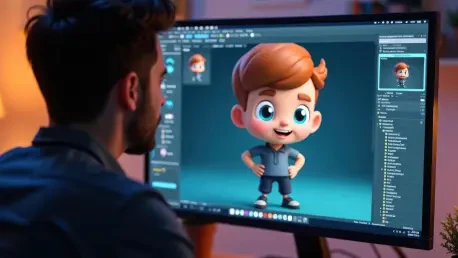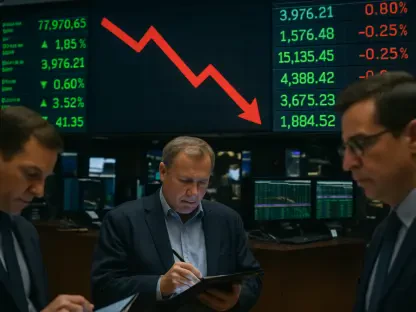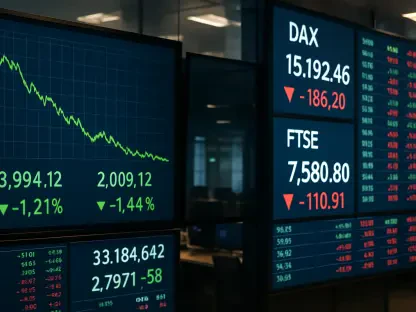The animation industry is undergoing a significant transformation, driven by the rapid advancement of generative AI technologies. Generative AI, currently influencing a market valued at USD 2.1 billion, is expected to expand to USD 15.9 billion by 2030 with a remarkable growth rate of 39.8% per year. This evolution is fundamentally altering how animation is produced and consumed, unleashing new levels of creativity and efficiency. The progression within AI technologies such as Generative Adversarial Networks (GANs) and real-time rendering is not only making high-quality, visually compelling animation more accessible but is also democratizing the industry. Beyond aesthetics, this technological leap has broader implications for storytelling and content creation.
Technology Driving Change
Generative Algorithms Transforming Animation
At the core of this revolution lies the application of generative algorithms, which are fundamentally altering the landscape of animation production. These algorithms, notably GANs, empower creators by automating time-intensive tasks like frame interpolation and texture generation. By reducing the technical burden, generative AI enables animators to invest more in creative endeavors, focusing on storytelling rather than technical details. The real-time capabilities afforded by integrating AI into advanced rendering engines, such as Unreal Engine 5, have significantly quickened production times, allowing for seamless creative workflows. This technological amalgamation ensures that high-quality animations can be produced efficiently, without the traditional constraints of time and resources.
Furthermore, the availability of generative AI tools has leveled the playing field, allowing small studios and indie creators to compete with major players. Traditionally dominated by well-funded firms, the industry is now open to innovation from any corner. With AI handling complex technical tasks, smaller teams can channel their efforts into unique, compelling stories, pushing creative boundaries. This democratization means an infusion of diverse perspectives in animation, which was previously hindered by financial and technological limitations. For the consumer, it means a broader array of content, enriched with varied narratives and aesthetics, enhancing the overall audience experience.
Market Dynamics and the Metaverse
Generative AI’s interaction with evolving market dynamics is noteworthy, heavily influenced by the growing prominence of the metaverse. The metaverse, an interconnected digital universe, is emerging as a formidable platform for animation, offering vibrant spaces for immersive experiences. This creates a new demand for real-time rendered content, where generative AI tools excel. Animators are now tasked with creating increasingly interactive and dynamic content that aligns with metaverse demands, further integrating generative AI into the creative workflow.
Countries like the U.S. and China are spearheading this transformative wave, leading the charge in both adopting and innovating generative AI applications for animation. Their role is pivotal in setting industry standards and trends, constantly pushing the envelope in integrating AI capabilities into animation workflows. As these regions drive the development of AI-driven animation, they also foster competitive landscapes where collaborative innovations thrive, setting a global benchmark. This trend toward a more AI-driven approach in animation not only promises efficiency but also opens a plethora of opportunities for strategists and creators to develop new market strategies attuned to regional and global trends.
The Path Forward
Creativity and Efficiency in Animation
Looking ahead, the interplay between generative AI and animation is poised to continually enhance creativity and efficiency, reshaping the industry. It encourages the embracement of novel storytelling techniques, which redefine how narratives are crafted and delivered. As AI advancements continue, creators will have unprecedented tools to explore visual and experiential aspects, pivoting traditional paradigms. This expansion is set to transform not just the visual aspects of animation but the storytelling medium itself, offering a canvas for unlimited exploration and expression.
In this evolving landscape, the potential for strategy development and innovative business models is immense. As generative AI tools become more accessible, they will inevitably change how content is created, distributed, and consumed. The strategic approaches drawn from this understanding could dictate competitive advantages for companies willing to navigate this shifting terrain. Moreover, creators are likely to explore collaborations and partnerships that could leverage AI’s full potential, fostering cross-industry innovations. Generative AI’s role will be central in cultivating an inclusive and versatile animation industry catering to diverse audiences with varied tastes.
Future Considerations
The animation industry is in the midst of a major transformation, spurred by advancements in generative AI technologies. This technology is making waves in a rapidly expanding market, currently valued at USD 2.1 billion and projected to soar to USD 15.9 billion by 2030, with a stunning annual growth rate of 39.8%. Generative AI is reshaping the production and consumption of animation, unlocking unprecedented creativity and efficiency. Significant progress in AI technologies, including Generative Adversarial Networks (GANs) and real-time rendering, is paving the way for more accessible, high-quality animations that captivate visually. This revolution not only democratizes the industry but also broadens prospects for storytelling and content creation. With AI, even those without traditional animation skills can contribute to producing compelling narratives. Thus, generative AI promises a future where animation thrives as a medium for diverse and rich storytelling, making it an exciting realm of possibility for creators worldwide.









